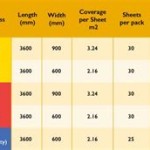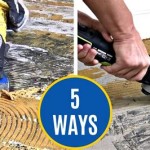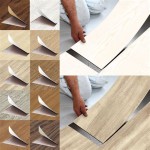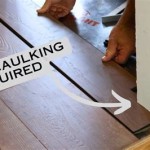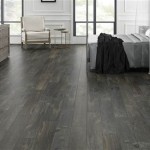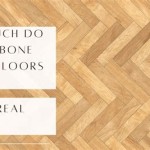How to Remove Carpet Tape Residue From Wood Floor
Removing carpet tape residue from a wood floor requires patience and a methodical approach. The adhesive used in carpet tape is designed to be strong, ensuring the carpet stays in place. However, this strength makes removing the residue a challenge, especially on a delicate surface like wood. Improper removal can damage the finish, potentially leading to costly repairs. Understanding the properties of the adhesive and the nature of the wood's finish is crucial for selecting the appropriate removal method.
The type of wood flooring significantly impacts the tools and techniques that can be safely employed. Hardwoods like oak, maple, and hickory are generally more resilient and can withstand slightly more aggressive cleaning methods. Softwoods, such as pine or fir, are more susceptible to scratching and damage, requiring gentler strategies. Similarly, the finish on the wood floor plays a vital role. Polyurethane finishes are relatively durable and resistant to solvents, while wax or oil-based finishes are more vulnerable. Knowing these details beforehand will prevent irreversible harm to the floor.
Before attempting any removal method, it is imperative to test a small, inconspicuous area of the floor. This test patch allows one to assess the effectiveness of the chosen method and identify any potential adverse reactions, such as discoloration or finish damage. The test area should be similar in condition to the area with the residue, ensuring accurate results. Document the results of the test patch, noting the amount of time the solution was applied and the effectiveness of the removal process. This detailed record will help in refining the removal strategy for the rest of the affected area.
Identifying the Type of Residue and Flooring
Accurately identifying the type of carpet tape residue is the first step in determining the best removal strategy. Older tapes often leave behind a more hardened, brittle residue, while newer tapes may leave a softer, stickier residue. The age of the residue can also influence its adherence to the wood floor. Older residues have often had more time to chemically bond with the floor's finish, making them more difficult to remove. Observe the texture and consistency of the residue. Is it gummy and pliable, or hard and flaky? This information will guide the selection of solvents and tools.
As previously mentioned, the type of wood flooring and its finish are crucial factors. Determine if the floor is hardwood or softwood. Examine the finish to determine if it is polyurethane, wax, or oil-based. If unsure, consult the flooring installation records or contact a flooring professional for assistance. Using the wrong cleaning agent on the wrong type of finish can lead to discoloration, dulling, or even complete stripping of the finish. Understanding the floor's composition is paramount to preserving its integrity.
Consider the quantity and distribution of the carpet tape residue. Is it a thin, even layer, or are there thick clumps of adhesive? The extent of the residue will influence the amount of time and effort required for removal. Heavily affected areas might necessitate multiple applications of a solvent or the use of more aggressive removal techniques, while lightly affected areas may only require gentle cleaning.
Effective Removal Methods
Several methods can be employed to remove carpet tape residue from wood floors, ranging from gentle to more aggressive approaches. Starting with the gentlest methods is always recommended to minimize the risk of damage. Patience is key; rushing the process can lead to mistakes that are difficult to correct. Thoroughly clean the area to be treated before starting, removing any loose debris or dirt that might interfere with the removal process.
One of the mildest methods involves using warm water and a mild dish soap. This approach is often effective for removing newer or softer residue. Mix a small amount of dish soap with warm water and apply the solution to the affected area. Allow it to sit for a few minutes to soften the adhesive. Then, gently scrub the residue with a soft cloth or sponge. Avoid using abrasive scrubbers, as they can scratch the finish. Repeat the process as needed until the residue is removed. Wipe the area dry with a clean cloth to prevent water damage.
Another effective method involves using heat. A hairdryer can be used to gently warm the adhesive, making it easier to peel away. Hold the hairdryer a few inches away from the residue and move it back and forth to avoid overheating the wood. Once the adhesive is warm, try peeling it away with a plastic scraper or putty knife. Be careful not to gouge or scratch the floor. If the residue is stubborn, reheat it and try again. Once the bulk of the residue is removed, use a soft cloth dampened with warm water to wipe away any remaining traces.
For more stubborn residue, mineral spirits or adhesive remover can be used. These solvents are effective at dissolving the adhesive but should be used with caution. Always wear gloves and eye protection when working with solvents. Apply a small amount of mineral spirits or adhesive remover to a clean cloth and gently rub the residue. Avoid pouring the solvent directly onto the floor, as this can damage the finish. Allow the solvent to sit for a few minutes to soften the adhesive, then wipe it away with a clean cloth. Repeat the process as needed. Once the residue is removed, clean the area with a damp cloth to remove any remaining solvent.
If the above methods are ineffective, consider using a plastic scraper or putty knife. Use caution to avoid scratching the wood. Apply gentle pressure and work the scraper under the edge of the residue. Try to peel the residue away in small pieces. If the residue is difficult to remove, try warming it with a hairdryer first. After scraping, use a solvent to remove any remaining traces of adhesive. Always test the scraper on an inconspicuous area first to ensure it does not damage the finish.
In some cases, a specialized adhesive remover formulated for wood floors may be necessary. These products are specifically designed to remove adhesive without damaging the finish. Follow the manufacturer's instructions carefully. Apply the remover to the affected area and allow it to sit for the recommended amount of time. Then, wipe away the residue with a clean cloth. Always test the product on an inconspicuous area first to ensure it does not damage the finish.
Preventing Future Residue Problems
Preventing carpet tape residue from accumulating on wood floors is preferable to dealing with the aftermath. Several strategies can be implemented to minimize the risk of future problems. Choosing the right type of tape and employing proper installation techniques can significantly reduce the likelihood of residue buildup.
Consider using residue-free carpet tape. These tapes are specifically designed to be easily removed without leaving behind adhesive. Look for tapes labeled as "residue-free" or "removable." While these tapes may not be as strong as traditional carpet tape, they are often sufficient for securing carpets in low-traffic areas. Always test the tape on a small, inconspicuous area of the floor before applying it to the entire carpet.
Another preventative measure is to use area rugs with non-slip backing. These rugs eliminate the need for carpet tape altogether. The non-slip backing provides traction, preventing the rug from sliding or bunching up. Choose rugs with backings made from materials that are safe for wood floors, such as natural rubber or felt. Avoid rugs with PVC or latex backings, as these materials can sometimes react with the finish on the wood floor.
When using carpet tape, apply it sparingly. Excessive use of tape can make removal more difficult and increase the amount of residue left behind. Apply tape only to the edges and corners of the carpet, where it is most likely to shift or bunch up. Avoid applying tape to the entire underside of the carpet. This will minimize the amount of adhesive that comes into contact with the wood floor.
Regularly inspect the carpet tape for signs of wear or damage. Replace the tape as needed to prevent it from becoming brittle or losing its adhesive properties. Old, dried-out tape is more likely to leave behind residue than fresh tape. Replacing the tape regularly will also help to prevent the adhesive from bonding too strongly with the floor's finish.
When removing carpet tape, do so as soon as it is no longer needed. The longer the tape remains on the floor, the more likely it is to leave behind residue. Remove the tape carefully, peeling it away slowly and evenly. Avoid pulling or tearing the tape, as this can cause it to break and leave behind more residue. If the tape is difficult to remove, try warming it with a hairdryer first.
By employing these preventative measures, maintaining a wood floor free from carpet tape residue can be achievable. Regular maintenance and mindful application of carpet tape are key to preserving the integrity and appearance of wood flooring.

Flooring How Can I Remove Carpet Adhesive From Hardwood Floors Home Improvement Stack Exchange

Removing Glue Or Adhesive From Hardwood Floors The Speckled Goat

Easy Ways To Get Rid Of Carpet Tape On Wooden Floors Or Stairs Floor Sanding

Best Cleaner Ever To Remove Sticky Tape From Floors Etc Safe Easy

How To Remove Double Sided Carpet Tape From A Wood Floor

Removing Glue Or Adhesive From Hardwood Floors The Speckled Goat

4 Ways To Remove Adhesive From A Hardwood Floor Wikihow

The Best Way To Remove Tape Residue From Hardwood Flooring Between Naps On Porch

Removing Glue Or Adhesive From Hardwood Floors The Speckled Goat

3 Fast Easy Ways To Remove Carpet Glue From A Wood Floor
See Also
